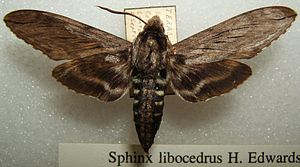Sphinx libocedrus
| Sphinx libocedrus | ||||||||||||
|---|---|---|---|---|---|---|---|---|---|---|---|---|

Preparation of Sphinx libocedrus |
||||||||||||
| Systematics | ||||||||||||
|
||||||||||||
| Scientific name | ||||||||||||
| Sphinx libocedrus | ||||||||||||
| Edwards , 1881 |
Sphinx libocedrus is a butterfly ( moth ) fromthe swarm family (Sphingidae). The range of Sphinx libocedrus covers parts of the central southwest of the USA .
features
The moths have a fore wing length of 29 to 36 millimeters and are among the smallest representatives of the genus. Their coloring is not variable. The forewings are pale blue-gray with a few pale black lines along the wing veins and the subterminal line. The species looks similar to Sphinx asellus , but the fine, short black line that arises from the apex is interrupted and not continuous in the similar species. On the underside of the hind wings there are also two white bands that are missing in the similar species. A white stripe runs along the more basal part of the forewing outer edge. The upper side of the hind wings is black and also has two white bands, the upper one being difficult to see.
The caterpillars are fully grown not only depending on the distribution area, but also quite variable within a population. Usually they are light green and have seven pairs of sloping, white side stripes on the body. The stripes on the back are bordered in purple. There is also a purple spot at the ventral end of each stripe that goes up to the spiracles . The area around the stripes is heavily provided with white secondary bristles, which give the body a rough appearance. Apart from these features, the individuals of the light green color variant differ with regard to the following additional features: There are those in which the anal horn and the spiracles are purple, the face is green and has pale, white vertical stripes that are finely bordered with black. The thoracic legs are yellow with the exception of the black tips of the claws. Other caterpillars have a bluish anal horn that is black granulated and white, black-rimmed stigmas. Her face is heavily spotted with black and bears a striking pair of yellow, vertical stripes that are finely bordered with black. The thoracic legs are completely black. In addition to these two green color morphs, there is also a dark morph in which the basic color is dark chocolate brown instead of green. The sloping side stripes are black, the face is brown. There is also a gray morph that has no pattern whatsoever.
The doll is reddish-brown and has a slightly grainy face. The head has a pair of black outgrowths near the base of the proboscis sheath. The long proboscis sheath is exposed, but lies pressed against the body and is significantly darker than the rest of the pupa. Their length is about 60% of that of the wings. The very short, rough kremaster is black and has a jagged tip.
Occurrence
The range of Sphinx libocedrus covers parts of the central southwest of the USA . The species is found mainly in Texas , New Mexico and Arizona , but has also been found in southwest Oklahoma , southern Nevada and the far east of San Bernardino County in California .
Sphinx libocedrus colonizes rocky areas of medium altitude between about 1000 and 1400 meters above sea level in the arid areas of the southwest. In the Rio Grande valley , the species also colonizes areas with significantly higher levels of precipitation with rocky limestone outcrops that are just a little above sea level.
Way of life
The crepuscular moths only occasionally fly to artificial light sources in individual specimens. Because of this, they were considered rare, which is not true. The species is proven when visiting the flowers of Oenothera hooleeri . In captivity, the moths hatch at dusk, with the females starting to attract males with pheromones shortly after they have unfolded their wings.
Flight and caterpillar times
Despite their relatively small range, the moths fly with significantly different flight times between mid-April and early October. In Arizona, one generation flies during the rains in July and August; in Texas, two generations appear to fly in the spring and fall. In the lower Rio Grande Valley, for example, moths were observed in mid-April and late September / early October. However, the data available for the evidence is still too small to be able to draw more precise conclusions about flight times and generations.
Food of the caterpillars
The caterpillars have been identified on Forestiera neomexicana , Forestiera shrevei , Forestiera angustifolia as well as Fraxinus gooddingii and Fraxinus greggii .
development
The females apparently lay their eggs individually on the underside of the leaves of the host plants. The caterpillars are diurnal and initially rest on the midrib on the underside of the leaves. Towards the end of their development they rest on the branches, but eat sitting freely on the younger shoots at the end of the branches. Pupation takes place in a chamber a few centimeters deep in the ground.
supporting documents
Individual evidence
- ↑ a b c d e f g h i James P. Tuttle: The Hawkmoths of North America, A Natural History Study of the Sphingidae of the United States and Canada. The Wedge Entomological Research Foundation, Washington, DC 2007, ISBN 978-0-9796633-0-7 .
- ↑ Sphingidae of the Americas. Bill Oehlke, accessed December 29, 2011 .
literature
- James P. Tuttle: The Hawkmoths of North America, A Natural History Study of the Sphingidae of the United States and Canada. The Wedge Entomological Research Foundation, Washington, DC 2007, ISBN 978-0-9796633-0-7 .